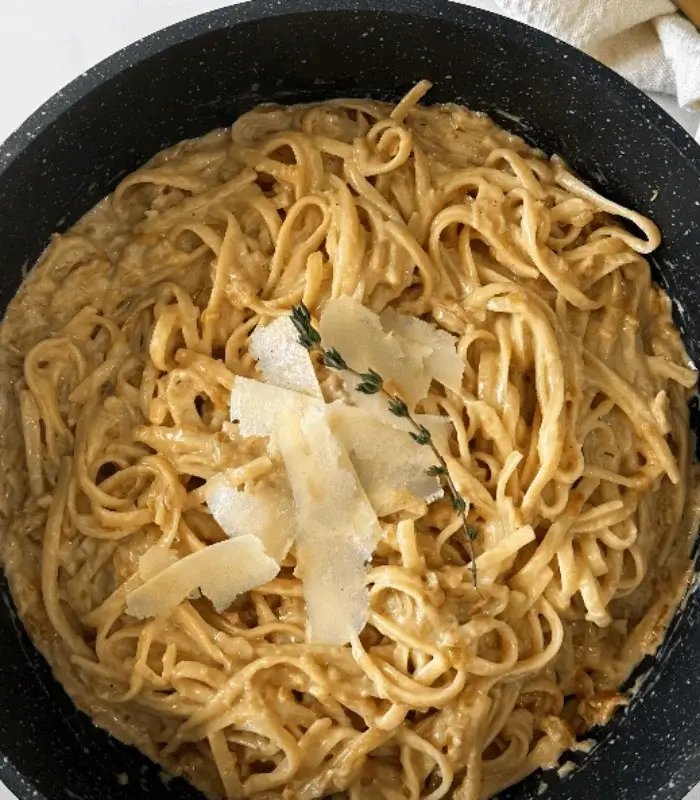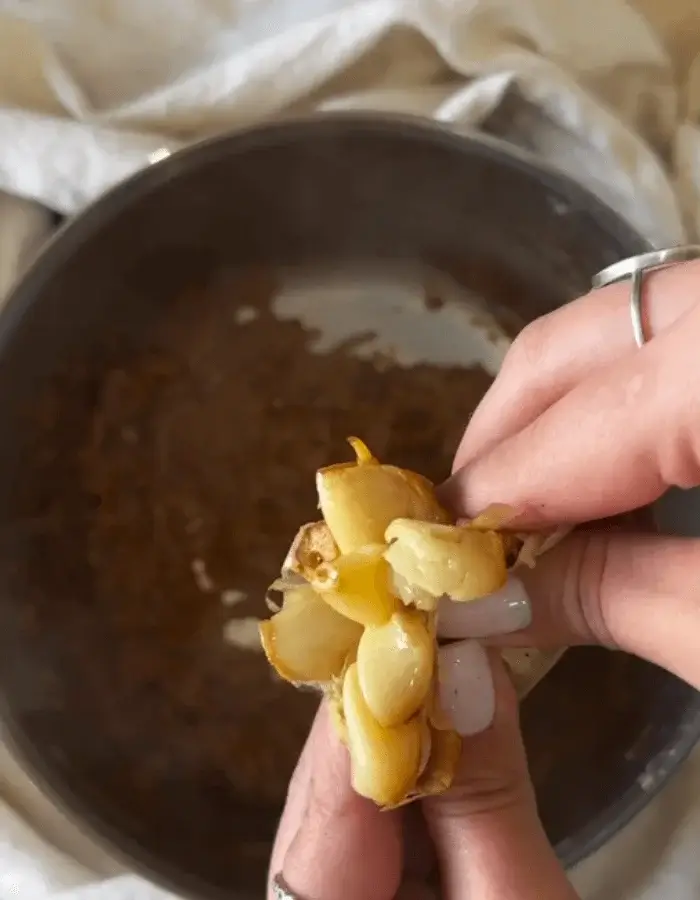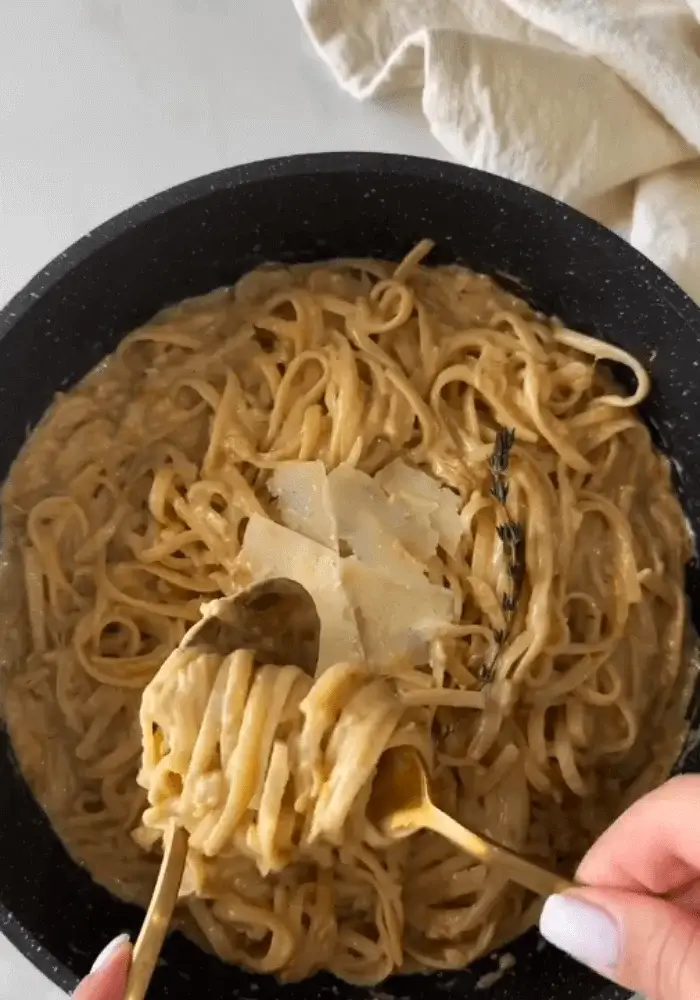Caramelized Onion Pasta with Shaved Parmesan
We may earn a commission from recommended products, at no extra cost to you. See Disclosure.
- Strainer
INGREDIENTS
- 1.1 pound/500 grams linguine
- 2 tablespoons butter
- 3 tablespoons olive oil
- 8 medium onions, thinly sliced
- 3 sprigs thyme
- 1 garlic head
- ⅓ cup dry white wine
- 1 cup heavy cream
- ⅓ cup whole milk
- ½ cup grated Parmesan cheese, plus more for serving
- 1 teaspoon salt
- ¼ teaspoon freshly ground black pepper
INSTRUCTIONS
- Preheat the oven to 350°F (180°C). Slice the top off a head of garlic, drizzle with olive oil, and wrap tightly in foil. Roast for 30 minutes, until the cloves are soft and golden.
- Meanwhile, heat the butter and olive oil in a wide skillet over medium heat. Add the sliced onions and reduce the heat to low. Cook slowly, stirring occasionally, until the onions are deeply caramelized, golden amber in color, and jam-like in texture. This can take 30 to 40 minutes. If the onions begin to stick, add a splash of water and stir.
- Once caramelized, add the thyme, roasted garlic (squeezed from the skins), and white wine. Let simmer for 1 to 2 minutes, just until the alcohol cooks off. Stir in the cream and milk, and simmer for 5 to 7 minutes, until the sauce thickens slightly. Season with salt and freshly ground black pepper to taste. Stir in the Parmesan.
- Cook the linguine according to package directions until al dente. Drain and add the pasta directly into the sauce, tossing to coat evenly. Serve hot, topped with extra Parmesan.

FAQ
Can I make caramelized onion pasta ahead of time?
The sauce, which includes caramelized onions, roasted garlic, cream, and Parmesan, holds up well in the refrigerator for up to 3 days. Cook and store the sauce separately from the pasta to prevent it from becoming soggy or overcooked when reheated. When ready to serve, cook fresh pasta, reheat the sauce gently on the stovetop while stirring, and combine them just before serving. You can also freeze the sauce in an airtight container for up to one month, then thaw and reheat as needed.

Best pasta shape to use for caramelized onion pasta?
The most commonly recommended pasta shape for caramelized onion pasta is linguine, due to its ability to hold a creamy sauce evenly across each strand. However, other long pasta shapes like fettuccine, tagliatelle, or even spaghetti also work well. The important factor is to use a pasta shape that allows the sauce to cling rather than slide off. Flat or slightly curved shapes are ideal, as they capture the caramelized onion bits and ensure each bite is well-coated. Avoid short tubular pastas like penne, which don’t catch the onion pieces as effectively in this particular sauce.
How to make this caramelized onion pasta dairy-free
You can substitute milk with non-dairy alternatives in caramelized onion pasta, but the results will vary depending on the type used. Unsweetened, unflavored almond, oat, or soy milk are the most neutral choices. Coconut milk is less ideal due to its distinct flavor, which may overpower the onions. Use non-dairy options with a similar fat content to whole milk to maintain the sauce’s richness. Be sure to check labels for added sugars or flavors that could affect the final taste. The texture may be slightly thinner, so adjust by simmering longer to achieve the right consistency.
What type of white wine works best here?
Look for options like Sauvignon Blanc, Pinot Grigio, or dry Chardonnay. These wines offer acidity and brightness that balance the sweetness of the caramelized onions and the richness of the cream. Avoid sweet or dessert wines, which can make the dish cloying. The wine is used to deglaze the pan after caramelizing the onions and helps lift any fond (browned bits) while adding complexity to the sauce. Since the alcohol cooks off during simmering, the wine’s flavor remains without overpowering the dish. Always use a wine you’d enjoy drinking.

Is there a vegan version of this caramelized onion pasta?
Replace the butter with plant-based butter or just use additional olive oil. Use unsweetened non-dairy milk such as oat or soy milk in place of dairy milk, and substitute the cream with coconut cream or cashew cream for richness. Instead of Parmesan cheese, opt for nutritional yeast or a vegan Parmesan alternative. The roasted garlic and caramelized onions still provide the same savory-sweet base. Make sure your pasta is egg-free, which most dried pasta options are. The final dish remains creamy and flavorful.
How do I store and reheat leftovers?
To store leftovers, transfer to an airtight container and refrigerate for up to 3 days. For best results, store the sauce and pasta separately if possible. When reheating, use a skillet over low heat with a splash of milk or water to loosen the sauce and prevent drying out. Stir frequently to heat evenly. Microwaving is an option but can lead to uneven texture; cover loosely and heat in short intervals while stirring in between. Avoid overheating, which may cause the cream to separate.
Can I freeze the sauce?
Yes, the sauce freezes well. Allow it to cool completely, then transfer to a freezer-safe container or bag. Label with the date and use within one month for best quality. When ready to use, thaw in the refrigerator overnight or defrost gently on the stovetop over low heat, stirring occasionally. Avoid freezing the sauce with pasta already mixed in, as the pasta can become mushy upon reheating. If the sauce separates slightly after thawing, whisk it gently or add a small splash of milk or cream to restore its smooth consistency.

